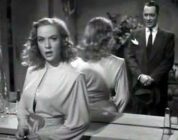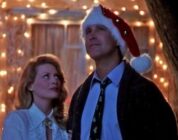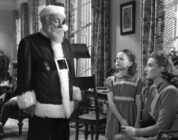Charles Dickens enjoyed great popularity in his lifetime, and that popularity hasn’t waned to this day. Despite an incredibly prolific assortment of characters and stories, which have been adapted to stage and screen over the years, perhaps the most iconic of them all (and certainly one of the most quotable) has proven to be Ebenezer Scrooge and A Christmas Carol. Though Dickens wrote other stories about Christmas, there is something about the old codger who learns the error of his ways that remains a cultural phenomenon, and indeed, the story has been loosely adapted numerous times to stage, radio, and, of course, film.
But perhaps even more astounding is that not only do so many versions of A Christmas Carol exist, but how different they all are from each other. From the advent of the motion picture itself, to the development of sound, to more modern adaptations of the story, there’s a version of A Christmas Carol for almost all tastes. Since covering them all would take almost as long as the Christmas season itself, what follows are several versions (in chronological order) that I myself have seen, ranging from the near perfect adaptations, to those taking advantage of the latest and greatest technologies, to simple guilty pleasures, and to those you may not have heard of before (and in some cases, for good reason).
____________________________________________________________
Scrooge, or, Marley’s Ghost (1901)
For silent film aficionados, this earliest surviving (though incomplete) version is a real gem to watch. Though it is heavily compressed (its original runtime was around 5 minutes or so, with about a minute of footage lost to time) and makes a rather large deviation by having Marley as the sole ghost showing Scrooge the past, present, and future, it is still a notable example of early cinema, with the sort of trick photography common in the era (note the scenes from the past shown on the black curtain in Scrooge’s room). However, as cinema was still in its infancy, its production budget seems miniscule even for the time period, as the sets are little more than stage set-ups with a stationary camera capturing the action. It also helps to know the story ahead of time…without any background knowledge, what appears onscreen is almost incomprehensible. As for Scrooge…well, let’s just say he doesn’t get a whole lot of screen time, other than to appear astounded at nearly everything around him. Probably not on a long list of anyone’s favorites, but as a relic of bygone days it is still remarkable.
Scrooge (1935)
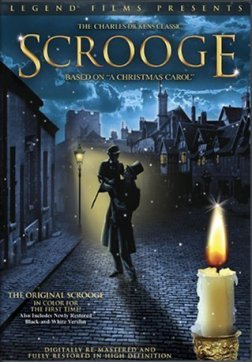 This early sound version (in fact, it is the earliest surviving sound version of the tale) stars Seymour Hicks, who had played Scrooge countless times on stage before taking on the role in this film. The movie itself is a rather oddball mishmash, with the 64-year-old actor playing both Scrooge as an old man and as a young man (and about as well as you’d expect anybody over the age of 60 to play a young man), portraying the ghosts of Marley, Past, and Future as invisible entities or shadows on the wall, and deleting a number of scenes to accommodate its short running time. To add insult to injury, the British version was chopped to ribbons upon its stateside release (and old VHS copies were actually sped up to twice their original speed), rendering the already truncated story almost unintelligible. A recent DVD version finally restored the cut as intended, though the shortened edition has made its way onto the Blu-ray format. It is perhaps not an iconic version of the story, but its very eccentricity makes it an enjoyable watch for those tired of the more notable adaptations.
This early sound version (in fact, it is the earliest surviving sound version of the tale) stars Seymour Hicks, who had played Scrooge countless times on stage before taking on the role in this film. The movie itself is a rather oddball mishmash, with the 64-year-old actor playing both Scrooge as an old man and as a young man (and about as well as you’d expect anybody over the age of 60 to play a young man), portraying the ghosts of Marley, Past, and Future as invisible entities or shadows on the wall, and deleting a number of scenes to accommodate its short running time. To add insult to injury, the British version was chopped to ribbons upon its stateside release (and old VHS copies were actually sped up to twice their original speed), rendering the already truncated story almost unintelligible. A recent DVD version finally restored the cut as intended, though the shortened edition has made its way onto the Blu-ray format. It is perhaps not an iconic version of the story, but its very eccentricity makes it an enjoyable watch for those tired of the more notable adaptations.
A Christmas Carol (1938)
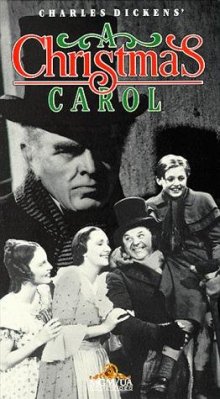 Ah, the American-born MGM Studios version. Here, Reginald Owen took on the time-tested character, with mixed results. Still, it’s a perennial favorite in my house, and like the Seymour Hicks version, takes a few liberties, mainly to make the film more family friendly (removing the thieves that steal Scrooge’s garments, for instance). However, not only was this one of the more popular adaptations of the story in the United States until the 1970s, it may be the only version where Scrooge actually fires Bob Cratchit (for ruining his hat, no less). Though Owen certainly plays the part with far more gusto and energy than his previous counterparts, and the film is certainly pretty to look at, its status was overwhelmed by a later British production that would become the version all other versions would be measured against…that production?
Ah, the American-born MGM Studios version. Here, Reginald Owen took on the time-tested character, with mixed results. Still, it’s a perennial favorite in my house, and like the Seymour Hicks version, takes a few liberties, mainly to make the film more family friendly (removing the thieves that steal Scrooge’s garments, for instance). However, not only was this one of the more popular adaptations of the story in the United States until the 1970s, it may be the only version where Scrooge actually fires Bob Cratchit (for ruining his hat, no less). Though Owen certainly plays the part with far more gusto and energy than his previous counterparts, and the film is certainly pretty to look at, its status was overwhelmed by a later British production that would become the version all other versions would be measured against…that production?
Scrooge (1951)
 Or, at least, as it was known in England. In the United States, this version is still known as A Christmas Carol, and with Alastair Sim as Scrooge, is perhaps the single most recognizable version that has yet been made. While not my favorite version of the story (that’s coming soon), it’s hard to deny Sim’s sheer talent in the role, thanks in part to the energy he places into it. He plays Scrooge early on as a relatively unpleasant, but humanized miser, but even as he grows more and more hysterical at what the ghosts show him, and the hysterical giddiness he contracts by the end, he remains in control and delightful every step of the way. But Sim isn’t the only one that crafts a remarkable performance; the entirety of the production is fantastic, from its moody sets, to the rest of the cast, and cinematography that makes the entire package a joy to watch. The appearance of Christmas Future starts with a simple hand held up in front of the camera, and that one scene carries so much emotional weight that it remains powerful to this day. And most telling of all, one of its lines, “Can you forgive a pig-headed old fool with no eyes to see with and no ears to hear with all these years,” was never written by Dickens, and yet remains an oft-remembered Scrooge quote…and when a quote is almost as widely remembered as what Dickens himself wrote, it’s a very impressive feat.
Or, at least, as it was known in England. In the United States, this version is still known as A Christmas Carol, and with Alastair Sim as Scrooge, is perhaps the single most recognizable version that has yet been made. While not my favorite version of the story (that’s coming soon), it’s hard to deny Sim’s sheer talent in the role, thanks in part to the energy he places into it. He plays Scrooge early on as a relatively unpleasant, but humanized miser, but even as he grows more and more hysterical at what the ghosts show him, and the hysterical giddiness he contracts by the end, he remains in control and delightful every step of the way. But Sim isn’t the only one that crafts a remarkable performance; the entirety of the production is fantastic, from its moody sets, to the rest of the cast, and cinematography that makes the entire package a joy to watch. The appearance of Christmas Future starts with a simple hand held up in front of the camera, and that one scene carries so much emotional weight that it remains powerful to this day. And most telling of all, one of its lines, “Can you forgive a pig-headed old fool with no eyes to see with and no ears to hear with all these years,” was never written by Dickens, and yet remains an oft-remembered Scrooge quote…and when a quote is almost as widely remembered as what Dickens himself wrote, it’s a very impressive feat.
Scrooge (1970)
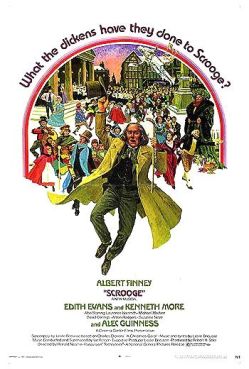 Popular in its time, then largely ignored, this musical version of the film, starring Albert Finney, is a “forgotten classic.” For one, Alec Guinness appears as the most hammy Marley of all-time; he was practically born for the role, eating up every minute of screen time with a performance both hysterical (notably the “sitting on thin air” routine as well as his gleeful gloating in one of the film’s climatic scenes) and frightening. Also, Finney plays one of the most grotesque Scrooges ever, a man who lives in squalor, appearing as if he doesn’t bathe, or, for that matter, clean his fingernails. But, despite what anyone make think of the caliber of songwriting, it is a very touching version of the tale, where we truly see Scrooge removed from the world around him. He has turned his back on the world because the world, he believes, has turned its back on him. Like the Alastair Sim version, this film also has many iconic scenes such as Belle weighing her engagement ring against two gold sovereigns (guess which wins). But what truly takes the cake is how thematically dark this version is. Not only are there some legitimately spooky ghosts (the disfigured ones flying outside Scrooge’s house, the funeral carriage, and the revelation of Christmas Yet to Come), this one comes complete with a musical number involving a man dancing in pure, unadulterated joy on a coffin as well as an oft-removed for TV scene in which Scrooge goes to Hell and sees what awaits him if he doesn’t change his tune. And this movie is rated G! Granted, it is two hours long, and it certainly isn’t perfect, but it is still a delightful telling, with a very exaggerated and endearing Scrooge in Finney, and anyone who says “Thank You Very Much” isn’t a catchy tune is either lying or vindictive. It is one of my favorite adaptations, and as its resurgence in popularity can attest (with its recent Blu-ray release, it is certainly much easier to find now than it was in the past); it’s certainly worth catching if you’ve never seen it. But beware of its somewhat misleading G-rating…be sure to cover your younger ones’ eyes and ears after Scrooge shouts, “I will repent!” Christmas Future’s exposed skull is pure nightmare fuel.
Popular in its time, then largely ignored, this musical version of the film, starring Albert Finney, is a “forgotten classic.” For one, Alec Guinness appears as the most hammy Marley of all-time; he was practically born for the role, eating up every minute of screen time with a performance both hysterical (notably the “sitting on thin air” routine as well as his gleeful gloating in one of the film’s climatic scenes) and frightening. Also, Finney plays one of the most grotesque Scrooges ever, a man who lives in squalor, appearing as if he doesn’t bathe, or, for that matter, clean his fingernails. But, despite what anyone make think of the caliber of songwriting, it is a very touching version of the tale, where we truly see Scrooge removed from the world around him. He has turned his back on the world because the world, he believes, has turned its back on him. Like the Alastair Sim version, this film also has many iconic scenes such as Belle weighing her engagement ring against two gold sovereigns (guess which wins). But what truly takes the cake is how thematically dark this version is. Not only are there some legitimately spooky ghosts (the disfigured ones flying outside Scrooge’s house, the funeral carriage, and the revelation of Christmas Yet to Come), this one comes complete with a musical number involving a man dancing in pure, unadulterated joy on a coffin as well as an oft-removed for TV scene in which Scrooge goes to Hell and sees what awaits him if he doesn’t change his tune. And this movie is rated G! Granted, it is two hours long, and it certainly isn’t perfect, but it is still a delightful telling, with a very exaggerated and endearing Scrooge in Finney, and anyone who says “Thank You Very Much” isn’t a catchy tune is either lying or vindictive. It is one of my favorite adaptations, and as its resurgence in popularity can attest (with its recent Blu-ray release, it is certainly much easier to find now than it was in the past); it’s certainly worth catching if you’ve never seen it. But beware of its somewhat misleading G-rating…be sure to cover your younger ones’ eyes and ears after Scrooge shouts, “I will repent!” Christmas Future’s exposed skull is pure nightmare fuel.
Mickey’s Christmas Carol (1983)
 When you have a character named after Scrooge, it’s pretty inevitable that he’d eventually play his namesake role someday. Animated with all the classic Disney characters taking part (and some, oddly enough, from Disney’s version of The Wind in the Willows), Scrooge McDuck learns the true meaning of Christmas. Cute for the young ones and funny enough for the older folks, and cut down quite effectively for a half-hour production, the story is stripped to its bare bones while still including some fine performances from Alan Young and the rest of the Disney ensemble. While this production was released theatrically as a short prior to several Disney reissues, it was also shown on television with additional Christmas themed Disney cartoons and woodcut interstitials where Mickey introduced each short with a quick voiceover…the resulting hour-long version has never been released on home video (though each short has been released uncut in separate collections).
When you have a character named after Scrooge, it’s pretty inevitable that he’d eventually play his namesake role someday. Animated with all the classic Disney characters taking part (and some, oddly enough, from Disney’s version of The Wind in the Willows), Scrooge McDuck learns the true meaning of Christmas. Cute for the young ones and funny enough for the older folks, and cut down quite effectively for a half-hour production, the story is stripped to its bare bones while still including some fine performances from Alan Young and the rest of the Disney ensemble. While this production was released theatrically as a short prior to several Disney reissues, it was also shown on television with additional Christmas themed Disney cartoons and woodcut interstitials where Mickey introduced each short with a quick voiceover…the resulting hour-long version has never been released on home video (though each short has been released uncut in separate collections).
A Christmas Carol (1984)
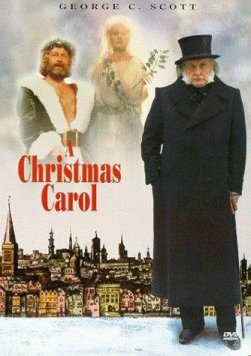 Another excellent adaptation, and perhaps the first film version to cast an American, George C. Scott, in the title role. Like the Albert Finney Scrooge, this is another version that, thanks to DVD and Blu-ray, has seen a well-deserved resurgence. Shown theatrically in England and on television in the United States, high production values, along with excellent period costumes, make for yet another fine watch. Scott’s portrayal is quite unique; his performance is incredibly low-key and subtle, and is perhaps the most human of all the versions…not a caricature of a man, but a “man of business,” and his confusion as to why he would be considered a miserly old man is perfectly understandable. His humor is very understated, and he is bolstered by a wonderful supporting cast, including the most vindictive Christmas Present on film (the late, great Edward Woodward), a very “everyman” Bob Cratchit (David Warner), and another wonderful Marley in longtime character actor Frank Finlay. Another classic version I’ve watched countless times, and one worth watching countless more.
Another excellent adaptation, and perhaps the first film version to cast an American, George C. Scott, in the title role. Like the Albert Finney Scrooge, this is another version that, thanks to DVD and Blu-ray, has seen a well-deserved resurgence. Shown theatrically in England and on television in the United States, high production values, along with excellent period costumes, make for yet another fine watch. Scott’s portrayal is quite unique; his performance is incredibly low-key and subtle, and is perhaps the most human of all the versions…not a caricature of a man, but a “man of business,” and his confusion as to why he would be considered a miserly old man is perfectly understandable. His humor is very understated, and he is bolstered by a wonderful supporting cast, including the most vindictive Christmas Present on film (the late, great Edward Woodward), a very “everyman” Bob Cratchit (David Warner), and another wonderful Marley in longtime character actor Frank Finlay. Another classic version I’ve watched countless times, and one worth watching countless more.
Blackadder’s Christmas Carol (1988)
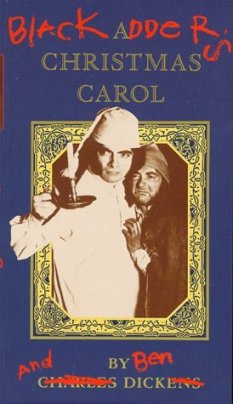 Who says every version of A Christmas Carol has to be played straight? Rowan Atkinson may be more well-known in America as Mr. Bean, but long before that character hit the TV screen, Atkinson had another hit character, Edmund Blackadder, whose four series progressed through four time eras, each starring a descendant (or possible reincarnation) of the original Edmund and his dimwitted manservant Baldrick. This TV retelling of the story follows an oddity in the Blackadder lineage, in which Ebenezer Blackadder is, in fact, the nicest, most generous man in all of England, and is constantly being taken advantage of by his less scrupulous neighbors and relatives. However, on Christmas Eve, he is inadvertently visited by the Ghost of Christmas, out on his rounds scaring old misers into being nice, and is shown how different things would be if he was as nasty and prone to backstabbing as his ancestors. This leads to a change of heart for Ebenezer, and he begins getting some well-deserved revenge. Atkinson’s humor and verve make the turnabout story charming and very funny (Blackadder’s gift of a fist to Baldrick is a classic moment), but some of it is a little dated (the vision of the future in particular). Plus, for those wowed by Hugh Laurie’s work on House might get a kick out of where he got his acting start. For lovers of British comedy, this is an absolute must-see.
Who says every version of A Christmas Carol has to be played straight? Rowan Atkinson may be more well-known in America as Mr. Bean, but long before that character hit the TV screen, Atkinson had another hit character, Edmund Blackadder, whose four series progressed through four time eras, each starring a descendant (or possible reincarnation) of the original Edmund and his dimwitted manservant Baldrick. This TV retelling of the story follows an oddity in the Blackadder lineage, in which Ebenezer Blackadder is, in fact, the nicest, most generous man in all of England, and is constantly being taken advantage of by his less scrupulous neighbors and relatives. However, on Christmas Eve, he is inadvertently visited by the Ghost of Christmas, out on his rounds scaring old misers into being nice, and is shown how different things would be if he was as nasty and prone to backstabbing as his ancestors. This leads to a change of heart for Ebenezer, and he begins getting some well-deserved revenge. Atkinson’s humor and verve make the turnabout story charming and very funny (Blackadder’s gift of a fist to Baldrick is a classic moment), but some of it is a little dated (the vision of the future in particular). Plus, for those wowed by Hugh Laurie’s work on House might get a kick out of where he got his acting start. For lovers of British comedy, this is an absolute must-see.
Scrooged (1988)
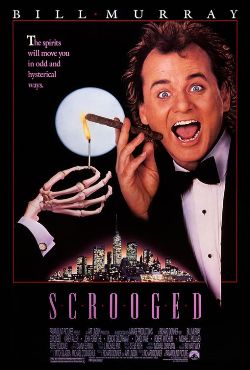 In the same year as the Atkinson film, we get a full-length feature, notable not only for its comedic slant, but also for its completely modern retelling. Instead of an old miser, we get young television executive Frank Cross (Bill Murray), who is so caught up with his ego and the commercialization of Christmas that he has forgotten what is really important in life. As such, the various ghosts all get an update as well, with Marley becoming the old head of the network, Christmas Past a 1940s cabbie, Christmas Present a…well, a completely insane and ultra-violent fairy, and Christmas Future an enormous monster with a soulless television set for a head. For Murray, subtlety is just an eight-letter-word…from the get go he lets his style of humor go to the extreme, and we get an over-the-top ego-maniac who doesn’t so much need redemption as much as he just needs a good kick in the pants (which Christmas Present is all too happy to provide). True, the 1980s power lunch-having executive and the Solid Gold Dancers do date the film a bit too much for its own good (as does “vodka poisoned by Chernobyl”), but there is still genuine feeling in the production, including a noteworthy addition to the tale that’s easy to miss…Cross gets to see that his own words turn one of the kindest people he knows into a miser like himself. Of all the versions of the story, this may be the first to imply that a few choice words or deeds can start the cycle of misery all over again, and shows that Dickens’ message loses no power no matter in what era the story takes place. Still, the real focus is on the comedy, and if there’s any guilty pleasure to get out of a less-than-faithful adaptation of A Christmas Carol, this one is definitely one of the more enjoyable entries. All I’d like to know is when will we finally see a proper release of Bob Goulet’s Old Fashioned Cajun Christmas?
In the same year as the Atkinson film, we get a full-length feature, notable not only for its comedic slant, but also for its completely modern retelling. Instead of an old miser, we get young television executive Frank Cross (Bill Murray), who is so caught up with his ego and the commercialization of Christmas that he has forgotten what is really important in life. As such, the various ghosts all get an update as well, with Marley becoming the old head of the network, Christmas Past a 1940s cabbie, Christmas Present a…well, a completely insane and ultra-violent fairy, and Christmas Future an enormous monster with a soulless television set for a head. For Murray, subtlety is just an eight-letter-word…from the get go he lets his style of humor go to the extreme, and we get an over-the-top ego-maniac who doesn’t so much need redemption as much as he just needs a good kick in the pants (which Christmas Present is all too happy to provide). True, the 1980s power lunch-having executive and the Solid Gold Dancers do date the film a bit too much for its own good (as does “vodka poisoned by Chernobyl”), but there is still genuine feeling in the production, including a noteworthy addition to the tale that’s easy to miss…Cross gets to see that his own words turn one of the kindest people he knows into a miser like himself. Of all the versions of the story, this may be the first to imply that a few choice words or deeds can start the cycle of misery all over again, and shows that Dickens’ message loses no power no matter in what era the story takes place. Still, the real focus is on the comedy, and if there’s any guilty pleasure to get out of a less-than-faithful adaptation of A Christmas Carol, this one is definitely one of the more enjoyable entries. All I’d like to know is when will we finally see a proper release of Bob Goulet’s Old Fashioned Cajun Christmas?
The Muppet Christmas Carol (1992)
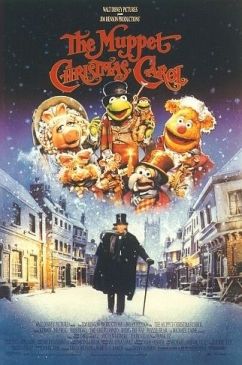 Amid a number of firsts how about the first version of Dickens’ classic to showcase the Muppets? Michael Caine takes on the title role here in another musical adaptation. Caine handles himself well and is clearly having fun, but admittedly isn’t the most notable actor to take on Scrooge…but that’s probably because this is a Muppet film, and they own this show from minute one. While none of the musical numbers is perhaps as affecting as the 1970 musical, none of them are unpleasant, either, and catchy in their own ways. It’s also probably one of the best versions for younger audiences to be introduced to the story, not only because of its usage of the original work (Gonzo as narrator quotes the book verbatim several times during the film), but it is funny, lighthearted, colorful, and almost not scary at all.
Amid a number of firsts how about the first version of Dickens’ classic to showcase the Muppets? Michael Caine takes on the title role here in another musical adaptation. Caine handles himself well and is clearly having fun, but admittedly isn’t the most notable actor to take on Scrooge…but that’s probably because this is a Muppet film, and they own this show from minute one. While none of the musical numbers is perhaps as affecting as the 1970 musical, none of them are unpleasant, either, and catchy in their own ways. It’s also probably one of the best versions for younger audiences to be introduced to the story, not only because of its usage of the original work (Gonzo as narrator quotes the book verbatim several times during the film), but it is funny, lighthearted, colorful, and almost not scary at all.
Disney’s A Christmas Carol (2009)
 I will admit I did not have particularly high hopes for this edition upon its release, though it does deserve credit as the first major motion picture version to be done entirely in motion capture computer graphics (and in 3D to boot). I came away marveling at how Zemeckis and company were able to make the film as emotional as they did. Jim Carrey, under thick layers of CG modeling, uses his remarkable expressions to great effect, and actually does what was thought impossible by acting with subtlety from time to time. While it does suffer from an overlong sequence to show off its 3D effects, the film does do the source material justice by being incredibly faithful to the original novel (the aforementioned 3D sequence being one of the exceptions) and wonderful use of close-ups truly enhance the emotions of the film. Never has Scrooge’s “You fell in love?” been quite so dramatic, or Bob Cratchit’s (Gary Oldman) distress over Tiny Tim. While not really in the realm of “classic” yet, it is likely to enter that realm, not simply on the strength of its animation, but in its heart as well.
I will admit I did not have particularly high hopes for this edition upon its release, though it does deserve credit as the first major motion picture version to be done entirely in motion capture computer graphics (and in 3D to boot). I came away marveling at how Zemeckis and company were able to make the film as emotional as they did. Jim Carrey, under thick layers of CG modeling, uses his remarkable expressions to great effect, and actually does what was thought impossible by acting with subtlety from time to time. While it does suffer from an overlong sequence to show off its 3D effects, the film does do the source material justice by being incredibly faithful to the original novel (the aforementioned 3D sequence being one of the exceptions) and wonderful use of close-ups truly enhance the emotions of the film. Never has Scrooge’s “You fell in love?” been quite so dramatic, or Bob Cratchit’s (Gary Oldman) distress over Tiny Tim. While not really in the realm of “classic” yet, it is likely to enter that realm, not simply on the strength of its animation, but in its heart as well.
____________________________________________________________
There are plenty more versions of A Christmas Carol out there, with actors like Kelsey Grammar and Patrick Stewart in the role of Scrooge, and countless TV shows adapting their characters into the parts (Mr. Magoo’s Christmas Carol, to name one), and even loose adaptations that put a new spin on the tale (Henry Winkler’s An American Christmas Carol, Jack Palance’s western Ebenezer, Susan Lucci’s female Scrooge in Ebbie, even David Zucker’s right-wing political parody An American Carol). Have I missed any versions you remember fondly, or perhaps a notable one that’s been overlooked in one way or another. Let us know about it. Who knows, maybe you’ll encourage someone to watch a new version of an old classic.

Seth Paul

Latest posts by Seth Paul (see all)
- Box Office Weekend: Eight Figure Box Office for Magnificent Seven - September 26, 2016
- Box Office Weekend: Sully Rides High for Second Week - September 19, 2016
- Box Office Weekend: Sully Lands On Target - September 12, 2016

